empirical conclusion
1. Experimental task 1
task1.asm
1 assume cs:code, ds:data 2 3 data segment 4 x db 1, 9, 3 5 len1 equ $ - x 6 7 y dw 1, 9, 3 8 len2 equ $ - y 9 data ends 10 11 code segment 12 start: 13 mov ax, data 14 mov ds, ax 15 16 mov si, offset x 17 mov cx, len1 18 mov ah, 2 19 s1:mov dl, [si] 20 or dl, 30h 21 int 21h 22 23 mov dl, ' ' 24 int 21h 25 26 inc si 27 loop s1 28 29 mov ah, 2 30 mov dl, 0ah 31 int 21h 32 33 mov si, offset y 34 mov cx, len2/2 35 mov ah, 2 36 s2:mov dx, [si] 37 or dl, 30h 38 int 21h 39 40 mov dl, ' ' 41 int 21h 42 43 add si, 2 44 loop s2 45 46 mov ah, 4ch 47 int 21h 48 code ends 49 end start
function:

Answer question ①
① line27, when the assembly instruction loop s1 jumps, it jumps according to the displacement. Check the machine through debug disassembly
What is the jump displacement of the code? (the displacement value is answered in decimal) from the perspective of CPU, it is explained
How to calculate the offset address of the instruction after the jump label s1.
Disassembly
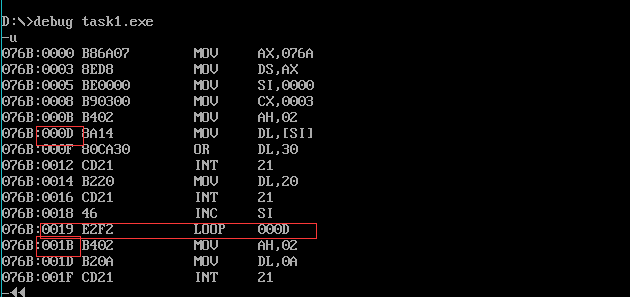
loop At s1, it jumps from 001B to 000D, and the displacement is - 14 (F2) bytes. At this time, the program has not run, so the displacement is calculated by 8086 CPU according to loop during assembly The calculated position and s1 size jump forward, so the displacement is negative, which is represented by complement in the machine code.
Answer question ②
② line44. When the assembly instruction loop s2 jumps, it jumps according to the displacement. Check the machine through debug disassembly
Code, analyze the jump displacement? (the displacement value is answered in decimal) from the perspective of CPU
How to calculate the offset address of the instruction after the jump label s2.
Disassembly
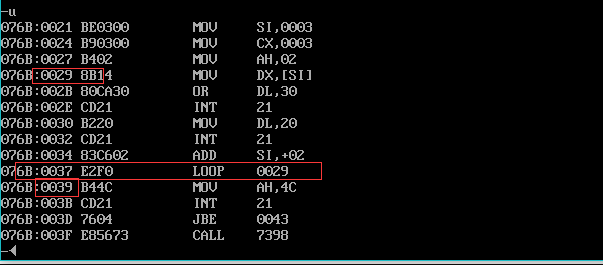
loop s2, from 0039 to 0029, the displacement is - 16 (F0) bytes. At this time, the program does not run, and the offset address is calculated during assembly.
2. Experimental task 2
task2.asm
1 assume cs:code, ds:data 2 3 data segment 4 dw 200h, 0h, 230h, 0h 5 data ends 6 7 stack segment 8 db 16 dup(0) 9 stack ends 10 11 code segment 12 start: 13 mov ax, data 14 mov ds, ax 15 16 mov word ptr ds:[0], offset s1 17 mov word ptr ds:[2], offset s2 18 mov ds:[4], cs 19 20 mov ax, stack 21 mov ss, ax 22 mov sp, 16 23 24 call word ptr ds:[0] 25 s1: pop ax 26 27 call dword ptr ds:[2] 28 s2: pop bx 29 pop cx 30 31 mov ah, 4ch 32 int 21h 33 code ends 34 end start
Disassembly:
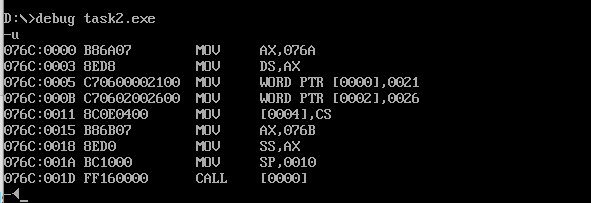
It can be seen that s1:0021, s2:0026 and CS: 076c are saved in DS: [0], DS [2] and DS [4] respectively.
According to the principle of call instruction, before the program executes to exit (line31), register ax should store ds:[0], register cx should store ds:[4], and register bx should store ds: [2],
Register (ax) =0021 Register (bx) = 0026 register (cx) = 076C
Results before program execution and exit:
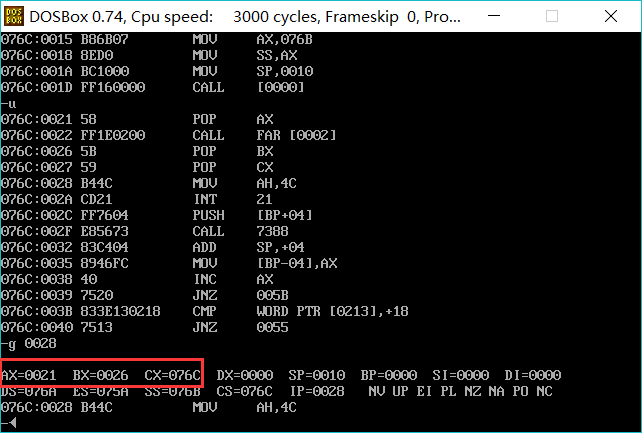
The results are consistent with the theoretical analysis.
3. Experimental task 3
Write the 8086 assembly source program task3.asm to output this group of continuous data in the data section in decimal form on the screen, and the data is separated by spaces.
The data in the data section is as follows:
data segment x db 99, 72, 85, 63, 89, 97, 55 len equ $- x data ends
requirement:
Write subroutine printNumber
Function: output a two digit number in decimal form
Entry parameter: register ax (data to be output -- > ax)
Outlet parameters: None
Write the subroutine printSpace
Function: print a space
Entry parameters: None
Outlet parameters: None
In the main code, the addressing mode and loop are comprehensively applied, and printNumber and printSpace are called to realize the subject requirements.
task3.asm code
1 assume cs:code, ds:data 2 data segment 3 x db 99, 72, 85, 63, 89, 97, 55 4 len equ $- x 5 data ends 6 code segment 7 start: 8 mov ax,data 9 mov ds,ax 10 mov si,0 11 mov cx,7 12 s: mov ax,0 13 mov al,ds:[si] 14 call s1 15 call s2 16 add si,1 17 loop s 18 mov ah, 4ch 19 int 21h 20 21 s1: mov bl,10 22 div bl 23 mov di,16 24 mov ds:[di],al;******shiwei 25 mov ds:[di+1],ah;****gwei 26 mov dl,ds:[di] 27 add dl,30h 28 mov ah,2 29 int 21h 30 mov dl,ds:[di+1] 31 add dl,30h 32 int 21h 33 ret 34 35 s2: mov dl," " 36 mov ah,2 37 int 21h 38 ret 39 40 code ends 41 end start
function:
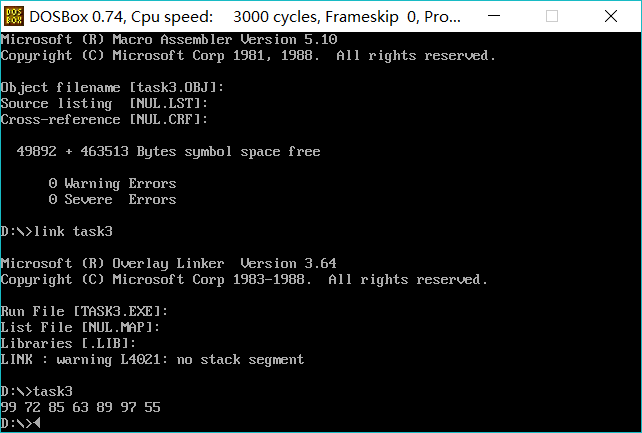
4. Experimental task 4
For 8086 CPU, the known logical segment is defined as follows:
data segment str db 'try' len equ $ - str data ends
Write 8086 assembly source program task4.asm, specify the color and line on the screen, and output the string on the screen.
requirement:
Write subroutine printStr
Function: display the string on the screen in the specified line and in the specified color
Entry parameters
The address of the first character of the string -- > ds: Si (where, the segment address of the segment where the string is located -- > DS, the offset of the starting address of the string)
Move address - > SI)
String length -- > CX
String color -- > bl
Specified line -- > BH (value: 0 ~ 24)
Outlet parameters: None
task4.asm Code:
1 assume cs:code, ds:data 2 data segment 3 str db 'try' 4 len equ $ - str 5 data ends 6 code segment 7 start: 8 mov ax,data 9 mov ds,ax 10 mov si,0 11 mov cx,3 12 mov bl,2;green 13 mov bh,0 14 call s1 15 mov si,0 16 mov cx,3 17 mov bl,4;gules 18 mov bh,24 19 call s1 20 mov ah,4ch 21 int 21h 22 23 s1:mov ax,0b800h 24 mov es,ax 25 mov al,bh 26 push bx 27 mov bl,160 28 mul bl 29 pop bx 30 s: mov dl,ds:[si] 31 mov dh,bl 32 mov di,ax 33 mov es:[di],dx 34 add ax,2 35 add si,1 36 loop s 37 ret 38 code ends 39 end start
function:
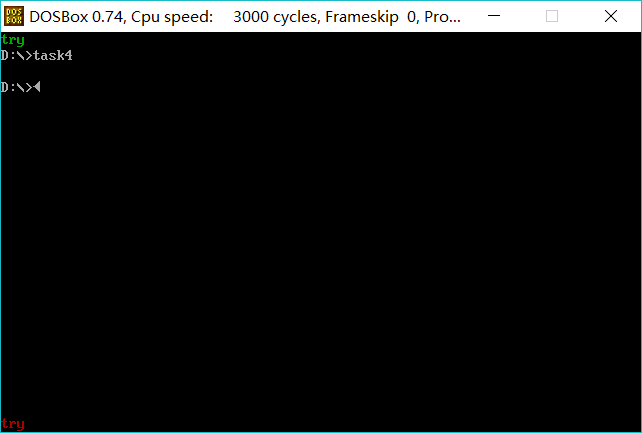
5. Experimental task 5
At 80 × In 25 color character mode, the student number is displayed in the middle of the last line of the screen. It is required that the student number and broken lines on both sides of the output window are displayed in white foreground.
1 assume cs:code, ds:data 2 data segment 3 stu_no db '201983290368' 4 len = $ - stu_no 5 data ends 6 code segment 7 start: 8 mov ax,data 9 mov ds,ax 10 mov ax,0b800h 11 mov es,ax 12 mov bl," " 13 mov bh,23 14 mov di,0 15 mov cx,780h 16 s:mov es:[di],bx 17 add di,2 18 loop s 19 20 mov cx,34 21 s1:mov bl,"-" 22 mov es:[di],bx 23 add di,2 24 loop s1 25 26 mov si,0 27 mov cx,12 28 s2:mov bl,ds:[si] 29 mov es:[di],bx 30 add di,2 31 add si,1 32 loop s2 33 mov cx,34 34 s3:mov bl,"-" 35 mov es:[di],bx 36 add di,2 37 loop s3 38 mov ah,4ch 39 int 21h 40 41 code ends 42 end start
function:
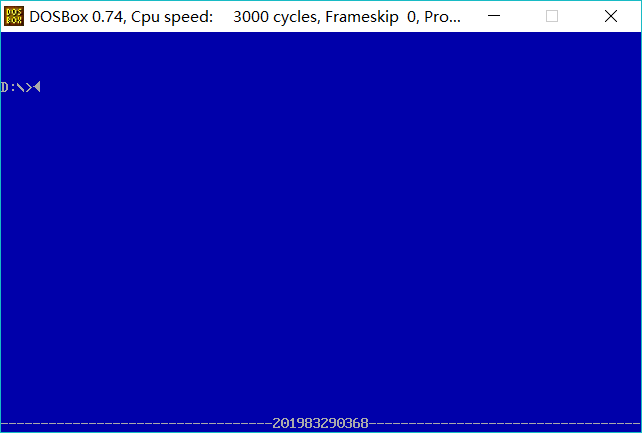
Experimental summary
The stack can solve the register conflict problem of subroutines. For some registers with special uses, such as cx, ax, etc., put the register on the stack before using the register in the subroutine, wait for it to return to the corresponding register after using it.